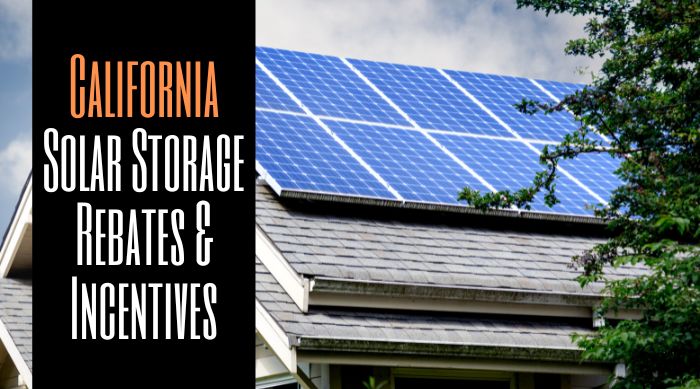If you invest in solar energy for your home, you are using technology to harvest the energy from sunlight and convert it to electricity. But unless you have a way to store that energy, the usefulness you get from solar isn’t necessarily at 100% unless you add a way to save that energy for later.

Fortunately, there are options such as the California Public Utilities Commission (CPUC) Self-Generation Incentive Program that can help homeowners offset the cost of investing in a solar battery system.
California Solar Storage Rebates & Incentives: SGIP
The Self Generation Incentive Program (SGIP) mentioned above is one of the longest-running solar programs offered to help those interested in going solar. SGIP offers rebates for solar storage technology for both residential and commercial properties, and state funding for this project was expected to exceed $1 billion USD through the year 2024.
That should give current and future homeowners an idea of how committed the State of California is to weaning itself off fossil fuels for home electricity. Combine that with other state mandates such as new residential construction including solar, and you have the makings of a serious move away from gas and oil for residential power.
Some Renters Included
You do not necessarily have to be a homeowner in order to claim SGIP incentives. Some renters qualify (see below) depending on the nature of the housing and other factors.
Time Counts
SGIP offers rebates for solar, but California residents don’t have an unlimited amount of time to access those options. It’s a “tiered-block” program, and over time the amount of the incentives will go lower as more and more people add solar storage to their homes.
Early adopters stand to benefit the most, while procrastinators may encounter smaller rebates depending on how long they wait to apply. At press time, thousands of dollars in savings were still on the table.
Some SGIP Funds Reserved For High-Risk Homes
A portion of SGIP funding is set aside for high-risk areas such as those prone to wildfires, and those that have experienced a qualifying number of “Public Safety Shut-Off Events”. Low-income and medically vulnerable citizens are also included in certain priority funding.
Claiming SGIP
The California Public Utilities Commission official site advises homeowners to reach out to a solar installer and ask for that vendor’s help to apply for the rebates. While the Commission site does provide a search tool to locate an installer, these vendors have not been vetted by the state, choose at your own risk.
Some encourage you to use a vendor marketplace to compare offers; in such cases, you may be able to find a more competitive offer that could save you a percentage on the install. But comparison shopping is key.
Who Qualifies For SGIP
According to the CPUC, “Any residential customer” of the following utility companies may qualify for a “General Market SGIP rebate”:
- Pacific Gas and Electric Company (PG&E)
- Southern California Edison (SCE)
- Southern California Gas Company (SoCalGas)
- San Diego Gas & Electric (SDG&E)
This offer covers about 25% of the average cost for a solar energy storage system. Residential customers may also qualify for two other SGIP options: Equity and Equity Resiliency.
SGIP Equity Rebates
Equity rebates provide as much as 85% of the cost of adding a solar storage system. To qualify for SGIP Equity rebates, you must meet one of the following criteria:
- You live in a single-family home subject to resale restrictions, or;
- You live in a single-family home and have already, or;
- You have participated in or have incentives in qualifying solar installation programs.
- You live in a low-income apartment that includes five rental units, and you are located in a qualifying community, or;
- You live in an apartment and your property has already participated in qualifying solar installation programs.
SGIP Equity Resiliency Rebates
This program covers nearly 100% of the cost of installing a solar storage system in a residence. The qualifying criteria for this program include having experienced at least two Public Safety Power Shut-Off events or living in a qualifying High Fire Threat District. One of the additional requirements must also apply:
- You live in multifamily deed-restricted housing, or;
- You live in a single-family home subject to resale restrictions, or;
- You are currently enrolled in a utility Medical Baseline Program, or;
- You have notified your utility of serious illness and/or life-threatening condition, or;
- You have received or reserved other solar-related, or;
- Your home relies on electric pump wells for water.
Federal Tax Benefits For Solar Storage
What follows is not tax advice. This is an explanation of a federal tax credit that has been offered in the past for qualifying homeowners. The Federal Investment Tax Credit has allowed homeowners to claim up to 26% of the cost of a solar battery as a write-off on federal income taxes, which could be worth up to $4000 in savings depending on circumstances.
The caveat? You cannot get the tax credit simply for buying a solar battery system. It must be paired with a solar rooftop system. Those who power their battery using electricity pulled from the electrical grid cannot claim this tax incentive.
Tax laws are subject to change. Last year’s deductions may not be allowed this year depending on the nature of those deductions. Always consult a tax professional about the current year’s tax laws for best results.
Solar Energy System California Property Tax Delay
One basic perk of installing a solar battery system? You may not have to pay higher property taxes right away for installing that improvement.
If you add solar to your home in California, you may be eligible for a property tax exclusion that delays an increase in those taxes; some vendors estimate that adding a solar system to your property values may increase up to 4.4% depending on circumstances.
Any delay in having to pay the increased property taxes could help you better offset the cost of installing a solar battery system.
Related Articles

